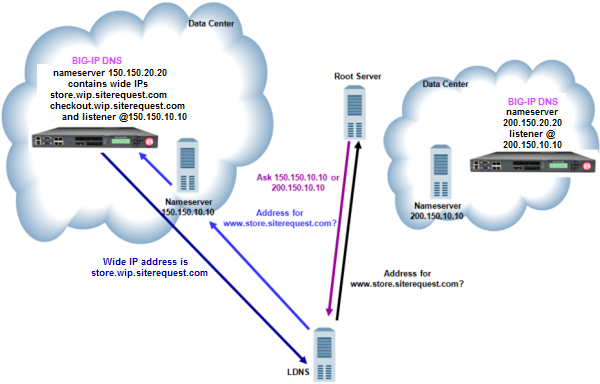Applies To:
Show Versions
BIG-IP DNS
- 13.0.1, 13.0.0
Overview: Delegating DNS traffic to wide IPs on BIG-IP DNS
BIG-IP® DNS resolves DNS queries that match a wide IP name. BIG-IP DNS can work in conjunction with an existing DNS server on your network. In this situation, you configure the DNS server to delegate wide IP-related requests to BIG-IP DNS for name resolution.

Traffic flow when DNS server delegates traffic to BIG-IP DNS
This implementation focuses on the fictional company SiteRequest that recently purchased BIG-IP DNS to help resolve queries for two web-based applications: store.siterequest.com and checkout.siterequest.com. These applications are delegated zones of www.siterequest.com. Currently, a DNS server manages www.siterequest.com.
SiteRequest administrators have already configured BIG-IP DNS with two wide IPs, store.wip.siterequest.com and checkout.wip.siterequest.com. These wide IPs correspond to the two web applications.
About listeners
A listener is a specialized virtual server that passively checks for DNS packets on port 53 and the IP address you assign to the listener. When a DNS query is sent to the IP address of the listener, BIG-IP DNS either handles the request locally or forwards the request to the appropriate resource.
Task summary
Perform these tasks to delegate DNS traffic to wide IPs on BIG-IP DNS.
Creating a delegated zone on a local DNS server
Determine which DNS servers will delegate wide IP-related requests to BIG-IP® DNS.
If you are using BIND servers and you are unfamiliar with how to modify the files on these servers, consider reviewing the fifth edition of DNS and BIND, available from O’Reilly Media.
- Create an address record (A record) that defines the domain name and IP address of each BIG-IP DNS in your network.
- Create a nameserver record (NS record) that defines the delegated zone for which BIG-IP DNS is responsible.
- Create canonical name records (CNAME records) for each web application, which forwards requests to store.siterequest.com and checkout.siterequest.com to the wide IP addresses of store.wip.siterequest.com and checkout.wip.siterequest.com, respectively.
Creating listeners to handle traffic for wide IPs
Implementation result
You now have an implementation of BIG-IP® DNS in which the DNS server manages DNS traffic unless the query is for store.sitrequest.com or checkout.siterequest.com. When the DNS server receives these queries, it delegates them to BIG-IP DNS, which then load balances the queries to the appropriate wide IPs.





